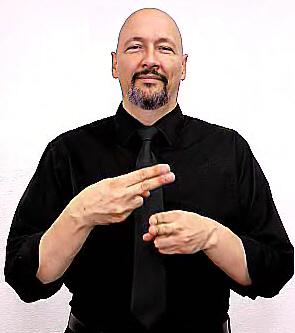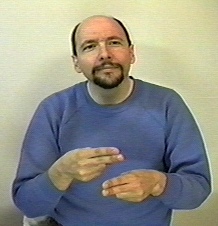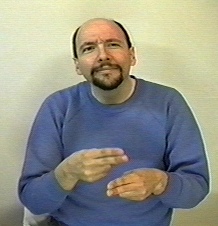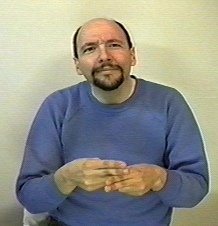American Sign Language: "name"
Video of "NAME"
Handshape: "H" handshape on both hands.
Movement: Tends to be a double movement (but a single movement is also common).
Non-Manual Marker: In general this uses a neutral facial expression. In the sentence "What is your name?" signed as NAME YOU? (Wh-question expression) you furrow the eyebrows and tilt the head forward a bit.Inflections: NAMED (verb) (When he was a puppy I named my dog Fido) [Note: For the verb version of this sign, I use a single movement.]
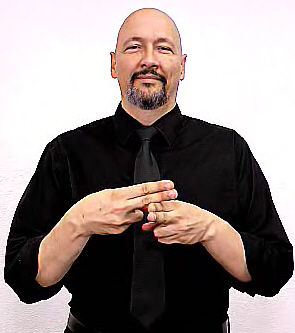
Sample usage: "What is your name?"
In the example below note my facial expression. The furrowed eyebrows, the tilt of my head, and the location of my hands all turn this one sign into a whole sentence: "What is your name?" You don't need any additional signs to express this meaning. This is often signed as "NAME YOU?" Or "YOUR NAME?"
Since some of you probably missed it I'm going to say this again. If you do the sign name using a single movement and single contact it generally becomes a verb meaning "named, called, christened, termed, etc."
Optional Reading (Not needed for class)
Question:
A student writes: I've been watching through your videos and reading at your website. I'm trying to learn my best about everything ASL! I've seen you do the sign for "NAME" using a double tap. I've also seen you sign NAME only tapped once. Is there a reason for this?
Response:
In general usage in everyday life with strong context the meaning of the sing NAME is almost always clear to the viewer regardless of one tap or two -- so doing a double movement (or not) isn't something to worry about -- however, here are some notes:
NAME can function as a noun / verb pair.
In general, signs that function as noun / verb pairs use a double movement for the noun and a single movement for the verb.
NAME can use a slightly extended single movement (single contact) to function as a verb. (For example: named, called, call, mention, christen, etc.)
NAME can use a double contact to function as a noun.
However, it is also true that in context the sign NAME can function as a noun even if it only uses a single movement.
The question "NAME YOU?" as in "What is your name?" (using furrowed eyebrows) often only uses a single movement for NAME. The question is understandable because it doesn't matter if NAME functions as a noun or a verb here. If you use a single movement to create a verb you are asking the technical equivalent of: "What are you named?" or "What are you called?" -- which is understood by your conversation partner as you wanting to know their name. (And is typically interpreted as: "What's your name?")
If for some reason it is important (such as teaching an English class via ASL in a Deaf classroom, you could use the single movement for verb concepts such as "named / called / christened" and could contrast those concepts with "name" by using a double movement to specify "name" as a noun.
Again though -- in typical everyday usage -- it just doesn't matter -- which is why you will see many skilled signers drop the second contact when signing the noun of a noun verb pair at high speed. (An example of that is how CHAIR is often done with a single movement).
Let's avoid the idea that there is one right way to sign things. Sure, there are ways to sign things that are so odd as to be considered wrong -- but that isn't my point. My point is to expect to see variation in the Deaf Community.
The question "What is your name?" -- is commonly done several different ways:
1. YOU NAME-(what - single contact)? (Look at the person, point at the person, furrow your eyebrows, sign NAME using a single contact)
2. NAME-(what - single contact) YOU? (Look at the person, furrow your eyebrows, sign NAME using a single contact, point at the person)
3. NAME-(what - double contact)? (Look at the person, furrow your eyebrows, sign NAME using a double contact)
4. YOU NAME WHAT? (Look at the person, point at the person, sign NAME using a single contact, furrow your eyebrows, sign WHAT-(loose hands version))
And so forth.
What I wish would happen:
Teacher: YOU NAME-(what)?
Student: J-O-H-N S-M-I-T-H.
What happens all too often:
Teacher: YOU NAME-(what)?
Student: MY NAME J-O-H-N S-M-I-T-H.
After teaching ASL for 30 years over 1,000 minutes of my life have been wasted watching students needlessly sign "MY NAME."
Math: (3.333R seconds) (3 x per semester) (100 students) (2 semesters per year) (30 years)
= approximately 60,000 seconds
= 1,000 minutes
Advanced discussion / not for ASL 1 classes:
Question: Can the verb form of name be used directionally to indicate that someone gave me a nickname?
Answer:
The verb form of the sign NAME with synonyms such as "named, call, gave a name to, called, christened" and so forth uses a single movement and single contact hold.
https://youtu.be/B4BSSkHZ5ic
The sign NAME can be undergo changes in location to derive new concepts.
Consider SIGNATURE is basically sticking your name on a piece of paper or contract.
Consider BRAND is sliding your name onto the side of a product, a building, or wall.
Consider the concept of a team name on a shirt can be shown by doing the BRAND sign as a locative on the chest.
The sign for NAME can employ "some" directionality but it is very limited and typically is not moved toward yourself (which would look like you are trying too hard to apply a linguistic principle and end up overextending the principle beyond what is used by actual skilled signers). An example of directionality with NAMED/called would be doing the sign generally toward a present referent. In other words if your dog is laying off to your right and your cat is off to your left you could choose to do the sign "NAMED" somewhat toward the right to refer to naming of your dog and do the sign somewhat toward your left to refer to the naming of your cat. However, NAMED is not as directional or "indicative" to the extent that a sign such as GIVE is directional. NAMED and TELL both lack the ability to incorporate an indication of the doer of the action. The doer needs to be established either via context or specifically indicating (via signing) who is the doer. NAMED is weaker than TELL in that TELL can be inflected to mean "TELL-me" whereas NAMED generally can't be inflected via direction of movement to mean NAME-me.
However you can do the X-hand version of GIVE-me and then sign NAME to mean "gave me a name" or "give me a name."
Also, There is an established sign for "nickname" that started out as a pun and gained traction to the extent that it shows up in typical signed communication between skilled signers.
Do the sign by pointing at your neck with an index finger (either touching or coming very close to the neck) then do the sign for NAME with a contact/brief hold (or in other words do not double tap the NAME part of the compound sign NECK-NAME (because it is a compound and exhibits a reduction of movement.
Nickname: https://youtu.be/AjTT29zx3SQ
Want to help support
ASL University? It's easy:
DONATE (Thanks!)
(You don't need a PayPal account. Just look for the credit card
logos and click continue.)
For a list of various ways to donate see:
https://www.Lifeprint.com/donate
Another way to help is to buy something from the ASLU "Bookstore."
Want even more ASL resources? Visit the "ASL Training Center!" (low
cost / high quality courses)
CHECK IT OUT >
A must see!:
ASL University's YouTube playlist ►
You can learn sign language online at American
Sign Language University ™
hosted by Lifeprint.com © Dr. William Vicars


